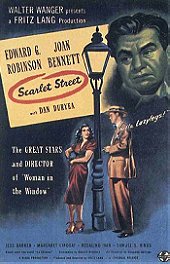Frtiz Lang once dubbed this film his personal favorite of his American work. Sometimes artists aren’t the best critics of their own work, but dubbing the Scarlet Street the favorite of his American work is a lucid statement. Hell, he could have said this one of his best works, and I couldn’t argue. Scarlet Street is clearly one of the all-time great film noirs.
The quartet of Lang, Edward G. Robinson, Joan Bennett, and Dan Duryea had collaborated on the prior year’s The Woman in the Window, which feels like a trial-run for this film. Both concern a mild-mannered man drawn into the erotic machinations of a femme fatale, who manages to encourage and blossom his capacity for violence. An early scene in which Robinson’s emasculated wannabe painter takes out Duryea’s pimp and saves Bennett gives a brief glimpse of the film’s major plot thread: Robinson’s secret enjoyment of violence.
The eventual unraveling of the rest of the plot goes into slightly expected noir territory, but something about these particular characters march towards their dark fates feels different than your typical noir. It’s hard to pin-down exactly. Scarlet Street continues the thread that in a noir, everyone must pay, some more than others, some innocents caught in the crossfire, but everyone pays. The characters in Scarlet Street pay and pay and pay.
Bennett’s femme fatale is almost cartoonish in her devilish tendencies. Her gum-smacking and boredom is palpable even in moments when she’s trying to turn on the charm and make Robinson do her bidding. Two scenes stood out in my viewing: one in which she hugs Robinson and whispers sweetly in his ear. Robinson is passionately kissing her neck and professing his love, Bennett is rolling her eyes and trying to keep her body language relaxed while her face is recoiling in terror. The second is much later, and sees Robinson happily bending down to paint Bennett’s toe nails. Imperious in nature and her voice filled with a dominatrix-like purr, she says “They’ll be masterpieces.” Her acidic nature threatens to destroy the film negative.
Bennett’s character is the secret weapon to making the film tick. Robinson beautifully plays out his character’s transition from hen-pecked to happily subservient to vengeful murder to nervous breakdown and homelessness. Duryea is just as good as snake in the grass major villain. He’s Bennett’s boyfriend, pimp, and full-time hustler, and Duryea makes him both charismatic and completely hissable. His consistent requests that she “charm” various male characters reads very clearly as to what the true nature of their relationship is. Yet much of Scarlet Street rests on Bennett being able to convincingly portray a woman who is happily engaged in a masochistic relationship with Duryea and capable of luring Robinson to his doom. She nails everything.
While The Woman in the Window let us off the hook by revealing that the entire thing was a dream, Scarlet Street doesn’t let us off so easily. It plays its pounding drum march to oblivion in measured tones. Finally, it culminates in Robinson, broken and destitute, wandering off into the streets with the voices of Bennett and Duryea haunting him. Everyone pays in noir, some more than others, but everyone pays.
 Login
Login